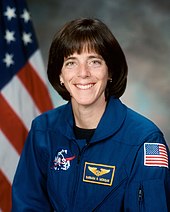Teacher in Space
The US project Teacher in Space (TISP) sends teachers into space to teach interesting things about space travel on television. It was announced on August 27, 1984 by then US President Ronald Reagan as a project of the US space agency NASA .
The Challenger Mission
The aim was to inspire schoolchildren and students, to give teachers recognition and to promote interest in the subjects of math, science and space exploration. Over 11,000 teachers applied for the program. In 1985, NASA then selected the teacher Christa McAuliffe , who was to fly on board as a payload specialist for the STS-51-L shuttle mission , the 25th space shuttle mission , in order to take students to Earth from space in two half hours teaching lessons about space travel and weightlessness that are televised. Barbara Radding Morgan was appointed as a substitute for this task in the event that McAuliffe should fail .
In her application for the Teacher-in-Space program, McAuliffe wrote:
“ As a woman, I was always jealous of men who could take part in the space program. I found that women were actually excluded from one of the most exciting professional fields there is. This opportunity to combine my skills as an educator with my interests in history and space travel is a unique chance to realize my earlier dreams. I was there when the space age was born, and I want to be part of it. "
A leak in one of the solid rocket rockets caused the tank to explode and the Challenger space shuttle to break apart 73 seconds after take-off at a height of around 15 kilometers . All seven astronauts were killed in the accident. Christa McAuliffe died at the age of 37.
New edition
The shuttle program had to be suspended for over two years, but immediately after the disaster, President Reagan announced that the Teacher in Space project would not be abandoned. "We are continuing our quest into space," he explained. "There will be more shuttle flights and more shuttle crews and, yes, more volunteers, more civilians, more teachers in space. Nothing comes to an end here; our hopes and our journeys continue."
However, NASA initially put the project on hold. It was not until the 1990s that the original idea was picked up again, but it was significantly modified under the name Educator Astronaut Project: Instead of preparing teachers in five-month training for a shuttle flight, who then offer a teaching program from space and the one after landing To continue their teaching profession again, NASA tried to make teachers into astronauts like others who should take on the same tasks in space as their colleagues and who should give up their teaching career in favor of an astronaut career for NASA. The background to this were security concerns about exposing "civilians" to a potentially life-threatening risk.
In January 1998, Barbara Radding Morgan was selected as NASA's first Educator Mission Specialist, twelve years after McAuliffe's death. She went through a complete astronaut training before she was designated for the flight of the shuttle mission STS-118 of the space shuttle Endeavor . Although the mission was always seen as a kind of reverence to McAuliffe, whose heir Morgan assumed in a certain way, NASA always emphasized the different backgrounds of the missions. Scott Kelly , commander of the STS-118 mission , explained :
“I don't have a teacher as a crewmember. I have a crewmember who used to be a teacher. "
“I don't have a teacher among my crew members. I have a crew member who used to be a teacher. "
Morgan was therefore involved in all the tasks on the shuttle, such as checking the heat shield. However, she gave the mission a 30-minute lesson on the seventh day of flight. She answered questions asked by students at the Discovery Center of Idaho. Another lesson took place on the ninth day of the flight, which Morgan conducted with Alvin Drew . This time, Morgan spoke to students at the Challenger Center for Space Science Education in Alexandria, Virginia. She later also spoke to students in the McCall Donnelly School District in Idaho via amateur radio ( SAREX project) after problems and a resulting delay .
Private initiatives
Independently of the shuttle program, efforts are being made to use suborbital manned flights into space, as planned as a result of the successful SpaceShipOne flights in 2004, also for flights with teachers. In 2006, for example, the Space Frontier Foundation announced a Teachers in Space program and signaled with the plural that it should not just be a one-off flight for a teacher. Armadillo Aerospace , Masten Space Systems , PlanetSpace , Rocketplane Limited, Inc. and XCOR Aerospace have agreed to provide capacities for such a project. The consultants for this project include the builder of SpaceShipOne, Burt Rutan , the founder of the X-Prize, Peter Diamandis , Apollo astronaut Edwin Aldrin , and the astronaut and financier of the X-Prize, Anousheh Ansari .
Individual evidence
- ↑ Teachers in Space! Foundation Wants Hundreds to Fly. The Space Frontier Foundation, April 11, 2006, accessed February 25, 2014 : "In 1984, when President Ronald Reagan created a Teachers in Space program to fly them on the Space Shuttle, more than 11,000 immediately applied."
- ↑ documents. Retrieved November 26, 2018 . (PDF file)
- ↑ Explosion of the Space Shuttle Challenger Address to the Nation, January 28, 1986. NASA History Office, June 7, 2004, accessed February 25, 2014 .
- ↑ BLAST OFF: Writer supports teacher in space program ( Memento of October 6, 2007 in the Internet Archive )
- ↑ http://www.space-frontier.org/PressReleases/2006/20060411teachersinspace.html
- ↑ http://www.space-frontier.org/PressReleases/2006/20060918TISMasten.html
- ↑ http://www.space-frontier.org/PressReleases/2006/20061016TISPlanetSpace.html
- ↑ http://www.space-frontier.org/PressReleases/2006/20060421teachersinspace.html


